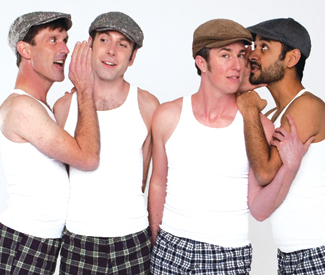arts@sfbg.com
DANCE This weekend choreographers Robert Moses and Sean Dorsey present new dances. Moses’ Helen, inspired by the myth of the beautiful Greek whose face launched a thousand ships, is at Yerba Buena Center for the Arts; Dorsey’s The Secret History of Love, based on how LGBT people used to meet, plays Dance Mission Theater. Both choreographers started dancing in their hometowns — Philadelphia for Moses, Vancouver for Dorsey — and began choreographing professionally in San Francisco. They recently talked to the Guardian about how they came to be where they are now.
SFBG Do you remember how dance entered your life?
Robert Moses We danced the way kids do. My sister and family members all danced. As teenagers we would get together in clubs where you showed your steps, and you had a contest. You couldn’t just jump around a little bit. You had to be the very best dancer that you could be.
Sean Dorsey My first memory is spinning round the living room in a leotard to “Free to Be … You and Me.” There was a lot of music in my house, lots of artists in my family, and there was a lot of space and encouragement for that kind of activity.
SFBG How did your formal training in dance start?
RM In my last semester in high school, I ended up in a dance class when another class was cancelled. At university, I started training in West African, Haitian, ballet, contemporary, tap, and musical theater. I did all of it because I knew that’s what I wanted to do.
SD My big childhood hero was Carol Burnett; my dream was to go into comedy. I was in graduate school in Community Development when I was invited to audition for the dance department. So I started to study dance at 25. It was going to be recreational, but I found that it was my deepest love.
SFBG We all bring our cultural background and life experiences to our work. If and in what way does that influence what you do?
RM Of course, it influences what you do; there is no way that it couldn’t. You are a member of group but you are also an individual who is changing and maturing. Sure, I have put perspectives on American, African American, and displacement issues. The thing to remember is what you do is not who you are.
SD As a transgendered person, a queer person, and an immigrant person, an outsider’s consciousness charges my art-making, and I hope that brings a heightened awareness and sensitivity to the kind of themes that I explore in my work such as family, love, or searching for a place in the world.
SFBG How does the process of making a new piece start?
RM It’s different each time. Sometimes it starts with a topic; sometimes with just a movement. A work might also tell me to lean more on the music or talk more about a subject. I also consider how a piece will be presented within a particular frame. The movement itself is created in the studio by the dancers and myself.
SD My process feels ridiculously long. All my pieces are accompanied by a sound score of narration and music. It takes four to six hours in the studio to make one minute. It’s always music, music, music and words, words, words. Once that is finished, I take the draft to the dancers and we make the movement together.
SFBG What would you like us to know about the upcoming premieres?
RM We are talking about the Greek Helen and the notion of an idealized woman, but also about the way people are the playthings of the gods. I am a fan of Carl Hancock Rux’s spoken word and music; he alludes to the Iliad but I am really interested in how women react to the situations they are in.
SD The show is based on archival research and features the real-life stories and voices of eight LGBT elders, from 1920s speakeasies to wartime love affairs, and the really repressive 1950s.
ROBERT MOSES’ KIN
Fri/30-Sun/1, 8 p.m., $25-$45
Novellus Theater
Yerba Buena Center for the Arts
700 Howard, SF
SEAN DORSEY DANCE
Thurs/28-Sun/1, 8 p.m. (also Sat/31-Sun/1, 4 p.m.), $10-$25
Dance Mission Theater
3316 24th St., SF

